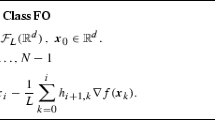Abstract
We prove the linear convergence rate of Hildreth's method for quadratic programming, in both its sequential and simulateneous versions. We give bounds on the asymptotic error constant and compare these bounds to those given by Mandel for the cyclic relaxation method for solving linear inequalities.
Similar content being viewed by others
References
S. Agmon, “The relaxation method for linear inequalities,”Canadian Journal of Mathematics 6 (1954) 382–392.
Y. Censor, “Row-action methods for huge and sparse systems and their applications,”SIAM Review 23 (1981) 444–466.
Y. Censor and G.T. Herman, “Row generation methods for feasibility and optimization problems involving sparse matrices and their applications,” in: I.S. Duff and G.W. Stewart, eds.,Sparse Matrix Proceedings 1978 (Society for Industrial and Applied Mathematics, Philadelphia, PA, 1979) pp. 197–219.
J.L. Goffin, “The relaxation method for solving systems of linear inequalities,”Mathematics of Operations Research 5 (1980) 388–414.
R. Gordon and G.T. Herman, “Three-dimensional reconstruction from projections: A review of algorithms,”International Review of Cytology 38 (1974) 111–151.
G.T. Herman and A. Lent, “Iterative reconstruction algorithms,”Computers in Biology and Medicine 6 (1976) 273–294.
G.T. Herman and A. Lent, “A family of iterative quadratic optimization algorithms for pairs of inequalities with applications in diagnostic radiology,”Mathematical Programming Study 9 (1978) 15–29.
C. Hildreth, “A quadratic programming procedure,”Naval Research Logistics Quarterly 4 (1957) 79–85. [Erratum,ibid., p. 361.]
A.N. Iusem and A.R. De Pierro, “A simultaneous iterative method for computing projections on polyhedra,”SIAM Journal on Control 25 (1986) 231–243.
S. Kaczmarz, “Angenäherte Auflösung von Systemen linearer Gleichungen,”Bulletin International de l'Academie Polonaise de Sciences et Lettres A35 (1937) 355–357.
A. Lent and Y. Censor, “Extensions of Hildreth's row-action method for quadratic programming,”SIAM Journal on Control 18 (1980) 444–454.
J. Mandel, “Convergence of the cyclical relaxation method for linear inequalities,”Mathematical Programming 30 (1984) 218–228.
O.L. Mangasarian, “Solution of symmetric linear complementarity problems by iterative methods,”Journal of Optimization Theory and Applications 22 (1977) 465–485.
T.H. Motzkin and I.J. Schoenberg, “The relaxation method for linear inequalities,”Canadian Journal of Mathematics 6 (1954) 393–404.
J.S. Pang, “More results on the convergence of iterative methods for the symmetric linear complementarity problem,”Journal of Optimization Theory and Applications 49 (1986) 107–134.
Author information
Authors and Affiliations
Additional information
Research of this author was partially supported by CNPq grant No. 301280/86.
On leave from the Universidade Federal do Rio de Janeiro, Instituto de Matemática, Rio de Janeiro, R.J. 21.910, Brazil. Research of this author was partially supported by NIH grant HL28438.
Rights and permissions
About this article
Cite this article
Iusem, A.N., De Pierro, A.R. On the convergence properties of Hildreth's quadratic programming algorithm. Mathematical Programming 47, 37–51 (1990). https://doi.org/10.1007/BF01580851
Received:
Revised:
Issue Date:
DOI: https://doi.org/10.1007/BF01580851




